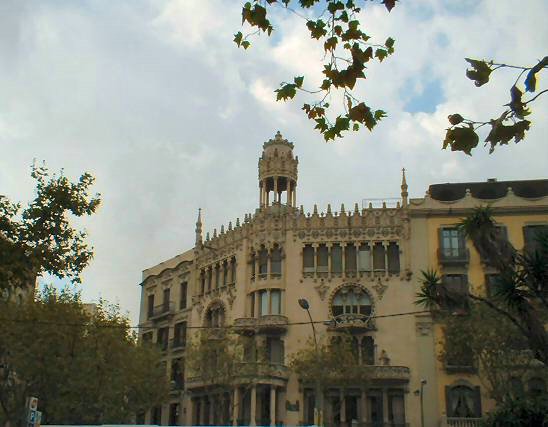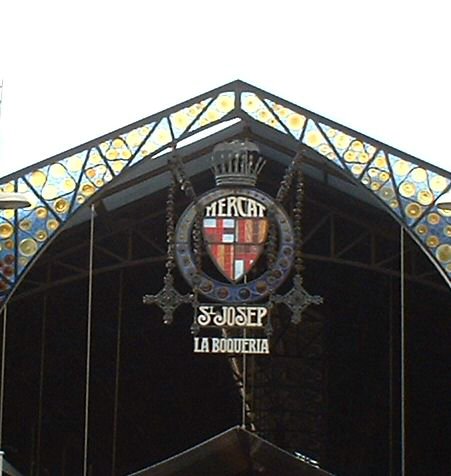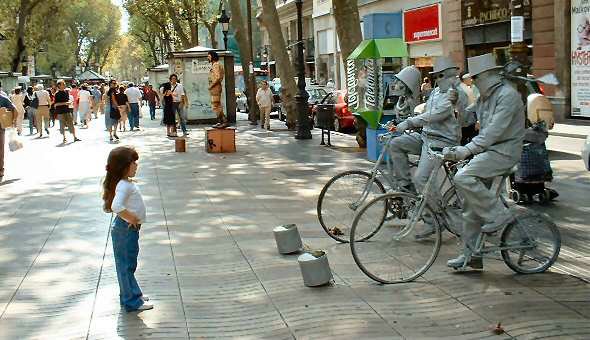Barcelona
is one of Spain's most important cities. The capital of Catalunya.
Well
known as a cultural centre, it boasts splendid architecture, monuments, historical
sites, natural resources, beaches and much more. It has developed over the last
decade and a half at a breathtaking pace. Some people say that it is Spain´s
most European city because it is always open to new ideas and trends. This can
be noted in its people, the Catalans. It is a very modern, multicultural, cosmopolitan
city.
Enjoying the benefits of a typical mediterranean climate Barcelona attracts tourists from all over the world. Following the Olympics in 1992 tourism to the city dramatically increased, partly due to the massive building programme and modernisation that went hand in hand with the games. Barcelona isn´t just the city itself mountians, beaches and villages are also within easy reach for tourists planning to spend more than just a few days in the province. Multinational companies based in Barcelona also contribute to the high number of foreign residents. Infact Barcelona is probably Spain's most cosmopolitan city.
Barcelona has such a rich heritage that you need at least a week to be able to visit it all. Here are what we consider to be the most important sites to visit.
The
actual city itself is quite large. But it is quite easy to find your way around
thanks to the way the streets are set out in grid form.
Walking: strolling around Barceloneta is a very pleasant experience - the old port Vell and the Atarazanas; the Maremagnum is a modern leisure centre featuring an Aquarium, restaurants, multiscreen cinema, shops, it also has bars with open terraces where you can enjoy a relaxing drink. Also within walking distance - The Ramblas, the Catalunya Square, the Gothic quarter, the Paseo de Gracia, the Avenida Diagonal with its fabulous shops, expensive boutiques, trendy cafes, bars and hotels. The Eixample (Ensanche) street with its modern buildings is now Barcelona´s business centre.
The atmosphere changes going from the Avenida Diagonal towards the north of the city which is more elegant and peaceful. The Pedralbes neighbourhood, Sant Gervasi and Sarriá (Av. Diagonal/Universitad north direction) are residential areas but worth a visit as they are very pretty. The Gracia neighbourhood has still got it´s old streets and continues to celebrate its fiestas and traditions. But perhaps the most interesting place to visit if you like art and history is the Gothic quarter (el barrio Gótico) especially during the weekend. There are many street musicians, singers, street theatre groups... allthis and more, something which creates a wonderful atmosphere. You can cross the whole area on foot going from the Ramblas to the Cathedral Square. The Real Square (Plaza Real) has a weekly antique market on Sundays (coins, stamps and old train sets among other things). Other places to see on foot are the Plaza del Pí (Iglesia del Pí), Plaza del Rei, Calle Montcada (an authentic medieval street), Basílica de Santa María del Mar, La Llotja, the Grand Lyceum theatre (Gran Teatro del Liceo) and the Mercado de la Boquería.

La Ciutadella Park, 30 hectres: a large lake, palm trees, orange trees...The Zoolological park is based here and also The Modern Art Museum.
Guell Park, magnificently built by Gaudi in 1922 this park is a world heritage.
Montjuic Mountain apart from the castle, there is a Roase garden and museums aswell as an open air theatre.a parte del Castillo y todos los Museos tiene un parque con una rosaleda, Mercat de las Flors, the Olympic Stadium, the Sant Jordi sports complex (used in the Olympics) and a theme park (El Poble Espagnol) .
Tibidabo Theme Park situated on Tibidabo mountain;
Also worth visiting are Joan Miró Park and l'Espanya Industrial Park.
The Congress Centre: located between the Plaza de España and the National Palace (Montjuic mountain). The Plaza de España was built for the 1929 Great Exhibition, its two bell towers forming the entrance to the site. From here you get onto Reina María Cristina avenue which is where the Congress Centre is (the former exhibition centre).
The Montjuich château: (18th century) located in Ciutat Vella has magnificent views over the Mediterranean, the Vell Port, the shipyards and the Olympic Port in the distance. It formed the headquarters to the Great Exhibition in 1929 and today serves as a military museum.
Guell Palace: neogothic palace built by Gaudi (his first building)
Virreina Palace: (18th century) the first person to inhabit this palace was the viceroy for Spain in Peru.
Pedralbes Palace: In the past it was used by the Spanish Royal family when visiting the city. Given National Historic status in 1931. Now open to the public, it has a museum with a permanent collection including decorative ceramic pieces, Catalan and Arabic pottery and works by Miró and Picasso. The gardens were designed by J.C.Forestier; Royale Mayor Palace, (13th century) used by the Counts of Barcelona and Royal family during that period. It houses the famous Tinell room (14th century) which was used by the Reyes Católicos (Catholic King and Queen) to welcome Christopher Columbus following his return from America..
The Mayor´s Office: also called the" Casa de la Ciutat " it is a 14th century palace which is located in the Gothic quarter (Barrio Gótico) in Sant Jaume square, in front of the Generalitat Palace.
The Generalitat Palace (the Catalan Parliament Palace): The renaissance facade has a statue of Sant Jordi, the Patron Saint of Barcelona. The head of parliament uses his office here daily or works across the road in his office in the Casa de los Canonges (Canónigos) which is connected by a Venecian style bridge built in 1928.
 Barcelona is the undisputed design centre of Spain. For clothes shopping the best place is the Paseo de Gracia and all the surrounding streets; there are also very good art, decoration and antique shops such as Bd-Ediciones de Diseño (pieces by Gaudí, Charles Mackintosh and other more modern designers), the Mercado de la Boquería - a food market - one of the biggest in Europe; El Mercat dels Encants - a secondhand market - a bit like the Rastro market in Madrid. The Gothic Quarter has a large number of specialist shops, usually very old, selling everything from hats to religious objects. Wines: we recommend the Penedès reds and rosés and white wines from Alella (bodegas Quilez).
Barcelona is the undisputed design centre of Spain. For clothes shopping the best place is the Paseo de Gracia and all the surrounding streets; there are also very good art, decoration and antique shops such as Bd-Ediciones de Diseño (pieces by Gaudí, Charles Mackintosh and other more modern designers), the Mercado de la Boquería - a food market - one of the biggest in Europe; El Mercat dels Encants - a secondhand market - a bit like the Rastro market in Madrid. The Gothic Quarter has a large number of specialist shops, usually very old, selling everything from hats to religious objects. Wines: we recommend the Penedès reds and rosés and white wines from Alella (bodegas Quilez).

As any major city, Barcelona has a very wide selection of hotels. Click on the links below for detailed reviews of the hotels we recommend.
| Travelling to Barcelona? The following links may also be useful | |
|---|---|
| Guides provinces bordering with Barcelona and beautiful places in Spain nearby | |